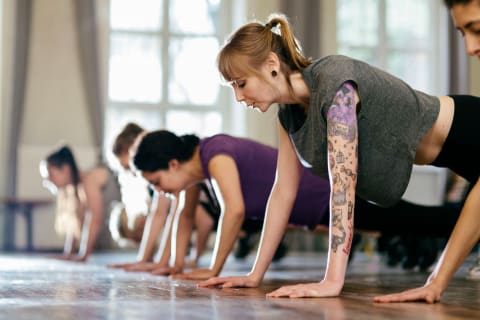1.Why do we roll to the right after savasana at the end of class and some times roll to the left ? Is there some significance to this? Traditionally in yoga you roll to the right during the day to honor the sun and roll to the left in the evening to honor the moon. 2. What is the right amount of time to wait after eating, before practicing yoga asana? And how long should I wait after practicing yoga before I can eat? ANSWER: Two hours after you eat is generally when you have an empty stomach and it’s okay to practice yoga. If you are starving and want to practice yoga but need some nourishment it’s fine to eat a banana or have a little juice to sustain you through the practice. Just no bean burritos before hitting the mat. After you practice I would wait 30 min for your body to reaclitmate and then eat. This way your body won’t go into food shock . 3. How often should I practice to have the best results? ANSWER: When first starting out try going twice a week then after one month start going three times per week. If you add up to going 5-6 days a week make sure you always have at least one day off so your body can recouperate. Also if you are practicing yoga almost everyday its good idea to mix up the style (i.e. power yoga one day, yin the next…) 4. Do I have to be flexible? ANSWER: No you don’t have to be flexible to do yoga… It’s an urban myth that people who are tight can’t do yoga. Yoga isn’t just stretching its extremely toning, calming, meditative, spiritual, healing and opening. Flexibility is only one aspect of it. Once you practice yoga for a period of time naturally you will gain flexibility with a myriad of other benefits. 5. Why are women told to avoid going upside down when menstruating? ANSWER: The idea is you don’t want to reverse the flow of the outward and downward moving energy (Apana). Apana is the energy that is being eliminated from your body and your menstrual period is a form of that outward moving energy. In yoga they say going upside down can reverse that effect and create blockages and problems… 6. What can and can’t pregnant women do in yoga ? ANSWER: Practicing in a heated room is the number one component to avoid in a yoga class, as getting over-heated can fry the baby’s neurons. Lying on the back can shut off blood to the baby and lying on the stomach can compress the baby. Inversions are not a great idea as your weight is different when pregnant then when you weren’t, so your center of balance is easily thrown off. I have seen pregnant women fall and its not fun for the mother or the baby. 7. Is yoga enough or should I compliment it with cardio and weight lifting? ANSWER: Yoga asanas are about creating a harmonious integration of breath and movement, so if you apply yogic breathing with cardio, weightlifting it can be considered a form of yoga. So I would mix it up if it feels appropriate. 8. What is Vinyasa or Power Yoga? ANSWER: Power yoga is a vinyasa style of yoga in which one pose is linked to the next by breath. It is a vigorous class and often modeled after poses in ashtanga yoga. 9. What is Hatha Yoga? ANSWER: “HA” means sun and “THA” means moon. Branches of the yoga practice that involve physical exercise, breathing practices, and movement. These exercises are designed to have a salutary effect on posture, flexibility, and strength and are intended ultimately to prepare the body to remain still for long periods of meditation. 10. What is Ashtanga Yoga? ANSWER: Patanjali’s eight-limbed path, also called Raja Yoga. This yoga contains or should contain eight components: morality; ethics; posture; breath control; sense control; concentration; meditation; absorption. Also the “brand” name for the style of yoga developed and taught by Sri K. Pattabhi Jois with a set sequence of yoga postures that take a student from A-Z in Asana. 11. What is Iyengar Yoga? ANSWER: Iyengar Yoga, created by B. K. S. Iyengar, is a form of yoga known for its use of props, such as belts and blocks, as aids in performing asanas (postures)… This style of yoga is extremely alignment based and the asanas are often practiced individually.



